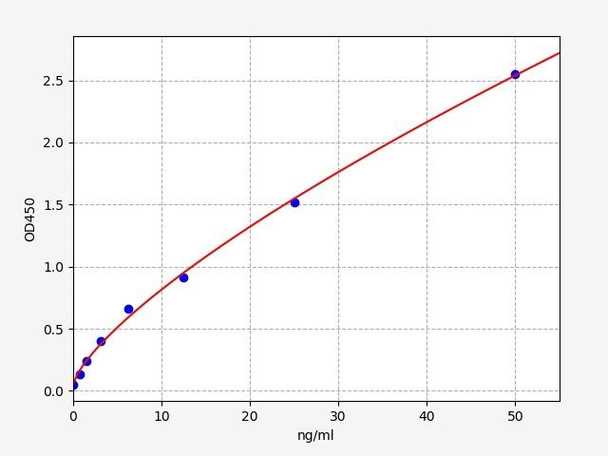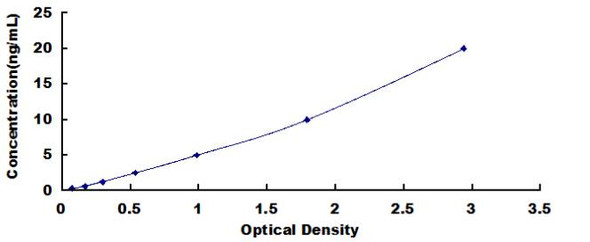Mouse HSF1 / Heat Shock Factor 1 ELISA Kit (MOFI00904)
- SKU:
- MOFI00904
- Product Type:
- ELISA Kit
- Size:
- 96 Assays
- Uniprot:
- P38532
- Sensitivity:
- 0.469ng/ml
- Range:
- 0.781-50ng/ml
- ELISA Type:
- Sandwich
- Synonyms:
- HSF1, HSTF1, heat shock factor protein 1, heat shock transcription factor 1HSTF1HSF 1
- Reactivity:
- Mouse
- Research Area:
- Epigenetics and Nuclear Signaling
Description
Mouse HSF1/Heat Shock Factor 1 ELISA Kit
The Mouse HSF1 (Heat Shock Factor 1) ELISA Kit is a powerful tool for quantifying levels of HSF1 protein in mouse samples including serum, plasma, and cell culture supernatants. With its exceptional sensitivity and specificity, this kit ensures accurate and reproducible results, making it an invaluable asset for a variety of research studies.HSF1 is a key regulator of the heat shock response, playing a critical role in cellular stress response pathways. Dysregulation of HSF1 has been implicated in a variety of diseases including cancer, neurodegenerative disorders, and metabolic disorders.
By measuring HSF1 levels, researchers can gain valuable insights into the mechanisms underlying these conditions and potentially identify new therapeutic targets. Overall, the Mouse HSF1 ELISA Kit from Assay Genie offers researchers a reliable and efficient method for investigating the role of HSF1 in health and disease, paving the way for new discoveries and advances in the field of molecular biology.
| Product Name: | Mouse HSF1 / Heat Shock Factor 1 ELISA Kit |
| Product Code: | MOFI00904 |
| Size: | 96 Assays |
| Alias: | HSF1, HSTF1, heat shock factor protein 1, heat shock transcription factor 1HSTF1HSF 1 |
| Detection Method: | Sandwich ELISA |
| Application: | This immunoassay kit allows for the in vitro quantitative determination of Mouse HSF1 concentrations in serum plasma and other biological fluids. |
| Sensitivity: | 0.469ng/ml |
| Range: | 0.781-50ng/ml |
| Storage: | 4°C for 6 months |
| Note: | For Research Use Only |
| Recovery: | Matrices listed below were spiked with certain level of Mouse HSF1 and the recovery rates were calculated by comparing the measured value to the expected amount of Mouse HSF1 in samples. | ||||||||||||||||
| |||||||||||||||||
| Linearity: | The linearity of the kit was assayed by testing samples spiked with appropriate concentration of Mouse HSF1 and their serial dilutions. The results were demonstrated by the percentage of calculated concentration to the expected. | ||||||||||||||||
| |||||||||||||||||
| Intra Assay: | CV <8% | ||||||||||||||||
| Inter Assay: | CV <10% |
| Component | Quantity | Storage |
| ELISA Microplate (Dismountable) | 8×12 strips | 4°C for 6 months |
| Lyophilized Standard | 2 | 4°C/-20°C |
| Sample/Standard Dilution Buffer | 20ml | 4°C |
| Biotin-labeled Antibody(Concentrated) | 120ul | 4°C (Protect from light) |
| Antibody Dilution Buffer | 10ml | 4°C |
| HRP-Streptavidin Conjugate(SABC) | 120ul | 4°C (Protect from light) |
| SABC Dilution Buffer | 10ml | 4°C |
| TMB Substrate | 10ml | 4°C (Protect from light) |
| Stop Solution | 10ml | 4°C |
| Wash Buffer(25X) | 30ml | 4°C |
| Plate Sealer | 5 | - |
Other materials and equipment required:
- Microplate reader with 450 nm wavelength filter
- Multichannel Pipette, Pipette, microcentrifuge tubes and disposable pipette tips
- Incubator
- Deionized or distilled water
- Absorbent paper
- Buffer resevoir
| Uniprot | P38532 |
| UniProt Protein Function: | HSF1: a transcription factor that specifically binds heat shock promoter elements (HSE) and activates transcription. Induced in response to heat, heavy metals, and oxidative stress. In higher eukaryotes, HSF is unable to bind to HSEs unless the cells are stressed. Becomes phosphorylated in response to stress, forming homotrimers that bind DNA and activate transcription. Phosphorylation by PLK1 enhances nuclear translocation, and phosphorylation by CaMKII enhances transactivation. Phosphorylation by GSK3 and ERK1 induces binding by 14-3-3 and sequestration in the cytoplasm. In addition, during attenuation from the heat shock response, HSF1 is repressed by direct binding of Hsp70, HSP40, and HSF binding protein 1 (HSBP1). Four alternatively spliced isoforms have been described. |
| UniProt Protein Details: | Protein type:Transcription factor; DNA-binding Cellular Component: nucleoplasm; protein complex; pronucleus; cytoplasm; nucleus Molecular Function:DNA binding; sequence-specific DNA binding; chromatin binding; transcription factor activity Biological Process: transcription from RNA polymerase II promoter; embryonic placenta development; transcription, DNA-dependent; in utero embryonic development; embryonic process involved in female pregnancy; female meiosis; defense response; response to lipopolysaccharide; negative regulation of transcription from RNA polymerase II promoter; positive regulation of multicellular organism growth; negative regulation of tumor necrosis factor production; protein amino acid phosphorylation; negative regulation of cell proliferation; regulation of transcription, DNA-dependent; response to heat; mRNA transcription; spermatogenesis; positive regulation of transcription from RNA polymerase II promoter |
| UniProt Code: | P38532 |
| NCBI GenInfo Identifier: | 33859480 |
| NCBI Gene ID: | 15499 |
| NCBI Accession: | NP_032322.1 |
| UniProt Secondary Accession: | P38532,O70462, |
| UniProt Related Accession: | P38532 |
| Molecular Weight: | 54,931 Da |
| NCBI Full Name: | heat shock factor protein 1 |
| NCBI Synonym Full Names: | heat shock factor 1 |
| NCBI Official Symbol: | Hsf1 |
| NCBI Official Synonym Symbols: | AA960185; Hsf1beta; Hsf1alpha |
| NCBI Protein Information: | heat shock factor protein 1; HSF 1; HSTF 1; Hsf1gammabeta; Hsf1gammaalpha; heat shock transcription factor 1 beta isoform; heat shock transcription factor 1 alpha isoform; heat shock transcription factor 1 gammabeta isoform; heat shock transcription factor 1 gammaalpha isoform |
| UniProt Protein Name: | Heat shock factor protein 1 |
| UniProt Synonym Protein Names: | Heat shock transcription factor 1; HSTF 1 |
| Protein Family: | Heat shock factor protein |
| UniProt Gene Name: | Hsf1 |
| UniProt Entry Name: | HSF1_MOUSE |
*Note: Protocols are specific to each batch/lot. For the correct instructions please follow the protocol included in your kit.
| Step | Procedure |
| 1. | Set standard, test sample and control (zero) wells on the pre-coated plate respectively, and then, record their positions. It is recommended to measure each standard and sample in duplicate. Wash plate 2 times before adding standard, sample and control (zero) wells! |
| 2. | Aliquot 0.1ml standard solutions into the standard wells. |
| 3. | Add 0.1 ml of Sample / Standard dilution buffer into the control (zero) well. |
| 4. | Add 0.1 ml of properly diluted sample (Human serum, plasma, tissue homogenates and other biological fluids.) into test sample wells. |
| 5. | Seal the plate with a cover and incubate at 37 °C for 90 min. |
| 6. | Remove the cover and discard the plate content, clap the plate on the absorbent filter papers or other absorbent material. Do NOT let the wells completely dry at any time. Wash plate X2. |
| 7. | Add 0.1 ml of Biotin- detection antibody working solution into the above wells (standard, test sample & zero wells). Add the solution at the bottom of each well without touching the side wall. |
| 8. | Seal the plate with a cover and incubate at 37°C for 60 min. |
| 9. | Remove the cover, and wash plate 3 times with Wash buffer. Let wash buffer rest in wells for 1 min between each wash. |
| 10. | Add 0.1 ml of SABC working solution into each well, cover the plate and incubate at 37°C for 30 min. |
| 11. | Remove the cover and wash plate 5 times with Wash buffer, and each time let the wash buffer stay in the wells for 1-2 min. |
| 12. | Add 90 µL of TMB substrate into each well, cover the plate and incubate at 37°C in dark within 10-20 min. (Note: This incubation time is for reference use only, the optimal time should be determined by end user.) And the shades of blue can be seen in the first 3-4 wells (with most concentrated standard solutions), the other wells show no obvious color. |
| 13. | Add 50 µL of Stop solution into each well and mix thoroughly. The color changes into yellow immediately. |
| 14. | Read the O.D. absorbance at 450 nm in a microplate reader immediately after adding the stop solution. |
When carrying out an ELISA assay it is important to prepare your samples in order to achieve the best possible results. Below we have a list of procedures for the preparation of samples for different sample types.
| Sample Type | Protocol |
| Serum: | If using serum separator tubes, allow samples to clot for 30 minutes at room temperature. Centrifuge for 10 minutes at 1,000x g. Collect the serum fraction and assay promptly or aliquot and store the samples at -80°C. Avoid multiple freeze-thaw cycles. If serum separator tubes are not being used, allow samples to clot overnight at 2-8°C. Centrifuge for 10 minutes at 1,000x g. Remove serum and assay promptly or aliquot and store the samples at -80°C. Avoid multiple freeze-thaw cycles. |
| Plasma: | Collect plasma using EDTA or heparin as an anticoagulant. Centrifuge samples at 4°C for 15 mins at 1000 × g within 30 mins of collection. Collect the plasma fraction and assay promptly or aliquot and store the samples at -80°C. Avoid multiple freeze-thaw cycles. Note: Over haemolysed samples are not suitable for use with this kit. |
| Urine & Cerebrospinal Fluid: | Collect the urine (mid-stream) in a sterile container, centrifuge for 20 mins at 2000-3000 rpm. Remove supernatant and assay immediately. If any precipitation is detected, repeat the centrifugation step. A similar protocol can be used for cerebrospinal fluid. |
| Cell culture supernatant: | Collect the cell culture media by pipette, followed by centrifugation at 4°C for 20 mins at 1500 rpm. Collect the clear supernatant and assay immediately. |
| Cell lysates: | Solubilize cells in lysis buffer and allow to sit on ice for 30 minutes. Centrifuge tubes at 14,000 x g for 5 minutes to remove insoluble material. Aliquot the supernatant into a new tube and discard the remaining whole cell extract. Quantify total protein concentration using a total protein assay. Assay immediately or aliquot and store at ≤ -20°C. |
| Tissue homogenates: | The preparation of tissue homogenates will vary depending upon tissue type. Rinse tissue with 1X PBS to remove excess blood & homogenize in 20ml of 1X PBS (including protease inhibitors) and store overnight at ≤ -20°C. Two freeze-thaw cycles are required to break the cell membranes. To further disrupt the cell membranes you can sonicate the samples. Centrifuge homogenates for 5 mins at 5000xg. Remove the supernatant and assay immediately or aliquot and store at -20°C or -80°C. |
| Tissue lysates: | Rinse tissue with PBS, cut into 1-2 mm pieces, and homogenize with a tissue homogenizer in PBS. Add an equal volume of RIPA buffer containing protease inhibitors and lyse tissues at room temperature for 30 minutes with gentle agitation. Centrifuge to remove debris. Quantify total protein concentration using a total protein assay. Assay immediately or aliquot and store at ≤ -20 °C. |
| Breast Milk: | Collect milk samples and centrifuge at 10,000 x g for 60 min at 4°C. Aliquot the supernatant and assay. For long term use, store samples at -80°C. Minimize freeze/thaw cycles. |






